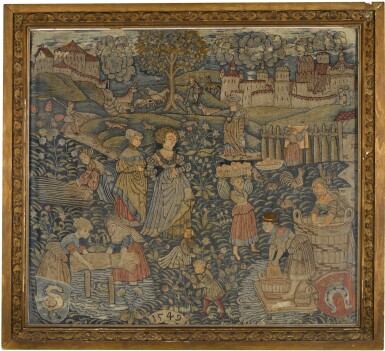
A PASTORAL EMBROIDERED PANEL, PROBABLY GERMAN, DATED 1549
Auction Closed
December 11, 04:05 PM GMT
Estimate
12,000 - 18,000 GBP
Lot Details
Description
A PASTORAL EMBROIDERED PANEL, PROBABLY GERMAN, DATED 1549
worked with couched, and raised, embroidered wools in gros and petit point, with metal-thread detailing, depicting figures including fine ladies visiting a washerwoman at a river bank, couched gold strip necklaces and hair decorations and knotted wool relief detailing to hats, with armorial shields to the lower corners of the Payersberg and Suppan families of the Tyrol and date 1549 worked to the centre of lower edge, mounted in a later glazed, giltwood frame
Glazed Frame: 93 by 102 by 6cm; 3ft., 3ft. 4in., 2in: Textile visible: 80 by 88cm; 2ft. 7in., 2ft. 10in.
‘Spetchley Park -I. Worcestershire, The Seat of Mr. R. V. Berkeley', Country Life, 8 July 1916, p. 45, illustrated in the Drawing Room
F. N. Payersberg, Armorial Generals by J.B. Reitstop, Vol II, pp. 400 and 868
The subject matter of the present 16th century piece is not overtly religious, and it reads as a pastoral and seasonal scene, and it could well have a moral message and represent the influence and patronage of families within a community, which in this example could be Payersberg and surrounding farm land. There are Germanic tapestries woven with complex allegories and moralising scenes, taken from popular literature and late medieval romances. For notable examples see those in the Burrell Collection, Glasgow, and the Basel Historical Museum. There was a wealth of source material which served as inspiration for both professional and amateur embroiderers, during the 16th century. The initiation of these sources began with German woodcuts, such as Furm und Modelbuchlein, 1523, and a later book, Johann Sibmacher's Schon neus Modelbuchlein, Nuremberg, 1597.
For a fascinating and especially evocative and rare, polychrome wool embroidered pastoral scene with the identifiable Swiss town of Bischofszell (Canton of Thurgau), and incorporating the coat of arms of the Bishop of Sonnenberg, see the The Bischofszell textile, Eastern Switzerland, worked on a dark woollen cloth (Margaret Ribbert, Historisches Museum, Basel: Inv. 1873.6.).
For extended footnote see Sothebys.com
